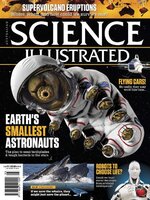Science Illustrated delivers natural science, break through discoveries and an understanding of the world for the entire family. Packed with stunning photography and in-depth editorial it’s a visually spectacular gateway to the world looking into the beginning of life to distant objects in the universe.
Science Illustrated Australia
MEGAPIXEL SUPERNOVAS
Earth’s carbon came from outer space • The carbon on Earth came here from interstellar space, according to new research. That contradicts earlier theories that carbon on Earth came more directly from the Sun during its formation.
Wasps help date an ancient kangaroo • A 2-metre-long drawing of a kangaroo has turned out to be the oldest in situ rock painting in Australia that has been reliably dated – so far.
Fusion energy will be ready in 2030 • American engineers are now promising pure fusion energy before 2030. If they can succeed, it could be an important step on the way towards green energy on a vast scale.
‘Zombie’ star found to emit extremely powerful X-rays • A star that died a long time ago at the centre of the Crab Nebula periodically emits very powerful X-rays.
Rare fossil of a crab brain shows evolution at a standstill • While bones and shells can endure for millions of years, soft tissues such as brains are rarely preserved as fossils.
Titan’s sea is 300 metres deep • We knew Saturn’s moon Titan has large oceans of liquid methane, but new research has established their substantial depth, paving the way for a NASA plan to explore the oceens with a space submarine.
Is all of the universe exactly the same age? • According to Einstein, time is relative and depends on your location in the universe. Does this mean that the universe is a different age if observed from a remote galaxy?
Why do tongue injuries heal so quickly? • “When I bite my tongue, I can taste blood in my mouth, but the ulcer disappears much faster than a wound might elsewhere. Why is that?”
How quickly does oil form? • Earth’s oil reserves might be exhausted one day. But how long does it take for new oil to form – and can the process be sped up?
How did cockatoos get ‘bin smart’? • Scientists are ‘contact-tracing’ the bin behaviour, and need your help.
Why do humans tend to see faces everywhere?
Has anyone invented a real bionic eye? • Cochlear’s ‘bionic ear’ is well-known and has been widely used since the first implant in 1978. But has anyone yet invented a bionic eye?
Who controls time around the world? • Who coordinates the time that governs the world’s time zones?
Which muscle is the body’s fastest? • Some performers of martial arts can make several strikes in a single second. But which muscle is the body’s fastest?
WHAT IS THIS? · Graphene • Graphene has been named as a wonder material, because of its extreme strength and incredibly thinness. But how thin is it, and why is it so strong?
What are freckles? • Why do freckles develop, and why do people have different quantities of them?
Could a solar storm kill all life on Earth? • In the 2009 film ‘Knowing’, a solar storm threatens to wipe out all life on Earth. Could it be that harmful in real life?
Oxygen rose from the ocean to become: THE FUEL FOR LIFE ON EARTH • You inhale 2000 litres of it every day, and it exists throughout the universe. But how oxygen rose into the atmosphere and made Earth inhabitable has remained a great mystery. Until now.
Greedy iron grabbed all the oxygen • When Earth formed, our planetary atmosphere included no oxygen gas. Then 3.6 billion years ago, organisms in the oceans began to convert CO2 into O2. Yet it took another 1.2 billion years before any significant quantity of oxygen molecules began escaping from the ocean to the...

 Issue 112
Issue 112
 Issue 111
Issue 111
 Issue 110
Issue 110
 Issue 109
Issue 109
 Issue 108
Issue 108
 Issue 107
Issue 107
 Issue 106
Issue 106
 Issue 105
Issue 105
 Issue 104
Issue 104
 Issue 103
Issue 103
 Issue 102
Issue 102
 Issue 101
Issue 101
 Issue 100
Issue 100
 Issue 99
Issue 99
 Issue 98
Issue 98
 Issue 97
Issue 97
 Issue 96
Issue 96
 Issue 95
Issue 95
 Issue 94
Issue 94
 Issue 93
Issue 93
 Issue 92
Issue 92
 Issue 91
Issue 91
 Issue 90
Issue 90
 Issue 89
Issue 89
